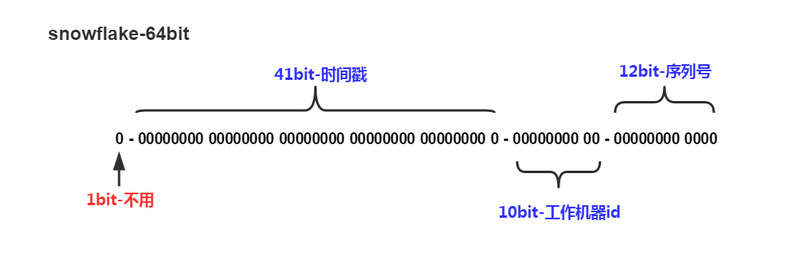Snowflake
算法介绍
Snowflake 是由 Twitter 提出的一个分布式全局唯一 ID 生成算法,算法生成 ID 的结果是一个 64bit 大小的长整,标准算法下它的结构如下图:

1 位,不用。- 二进制中最高位为符号位,我们生成的
ID一般都是正整数,所以这个最高位固定是 0。
- 二进制中最高位为符号位,我们生成的
41 位,用来记录时间戳(毫秒)。41 位可以表示2^41 - 1个数字。- 也就是说
41 位可以表示2^41 - 1个毫秒的值,转化成单位年则是(2^41 - 1) / (1000 * 60 * 60 * 24 * 365)约为69年。
10 位,用来记录工作机器ID。- 可以部署在
2^10共1024个节点,包括5位DatacenterId和5位WorkerId。
- 可以部署在
12 位,序列号,用来记录同毫秒内产生的不同id。12 位可以表示的最大正整数是2^12 - 1共4095个数字,来表示同一机器同一时间截(毫秒)内产生的4095个ID序号。
Snowflake 可以保证:
- 所有生成的
ID按时间趋势递增。 - 整个分布式系统内不会产生重复
ID(因为有DatacenterId (5 bits)和WorkerId (5 bits)来做区分)。
Hyperf 的 hyperf/snowflake 组件在设计上提供了很好的可扩展性,允许您通过简单的扩展就能实现其它基于 Snowflake 的变体算法。
安装
composer require hyperf/snowflake
使用
框架提供了 MetaGeneratorInterface 和 IdGeneratorInterface,MetaGeneratorInterface 会生成 ID 的 Meta 文件,IdGeneratorInterface 则会根据对应的 Meta 文件生成 分布式 ID。
框架默认使用的 MetaGeneratorInterface 是基于 Redis 实现的 毫秒级别生成器。
配置文件位于 config/autoload/snowflake.php,如配置文件不存在可通过执行 php bin/hyperf.php vendor:publish hyperf/snowflake 命令创建默认配置,配置文件内容如下:
<?phpdeclare(strict_types=1);use Hyperf\Snowflake\MetaGenerator\RedisMilliSecondMetaGenerator;use Hyperf\Snowflake\MetaGenerator\RedisSecondMetaGenerator;use Hyperf\Snowflake\MetaGeneratorInterface;return ['begin_second' => MetaGeneratorInterface::DEFAULT_BEGIN_SECOND,RedisMilliSecondMetaGenerator::class => [// Redis Pool'pool' => 'default',// 用于计算 WorkerId 的 Key 键'key' => RedisMilliSecondMetaGenerator::DEFAULT_REDIS_KEY],RedisSecondMetaGenerator::class => [// Redis Pool'pool' => 'default',// 用于计算 WorkerId 的 Key 键'key' => RedisMilliSecondMetaGenerator::DEFAULT_REDIS_KEY],];
框架中使用 Snowflake 十分简单,只需要从 DI 中取出 IdGeneratorInterface 对象即可。
<?phpuse Hyperf\Snowflake\IdGeneratorInterface;use Hyperf\Utils\ApplicationContext;$container = ApplicationContext::getContainer();$generator = $container->get(IdGeneratorInterface::class);$id = $generator->generate();
当知道 ID 需要反推对应的 Meta 时,只需要调用 degenerate 即可。
<?phpuse Hyperf\Snowflake\IdGeneratorInterface;use Hyperf\Utils\ApplicationContext;$container = ApplicationContext::getContainer();$generator = $container->get(IdGeneratorInterface::class);$meta = $generator->degenerate($id);
重写 Meta 生成器
分布式全局唯一 ID 的实现方式多种多样,也有很多基于 Snowflake 算法的变体算法,虽然都是 Snowflake 算法,但也不尽相同。比如有人可能会根据 UserId 生成 Meta,而非 WorkerId。接下来,让我们实现一个简单的 MetaGenerator。
简单的来讲,UserId 绝对会超过 10 bit,所以默认的 DataCenterId 和 WorkerId 肯定是装不过来的,所以就需要对 UserId 取模。
<?phpdeclare(strict_types=1);use Hyperf\Snowflake\IdGenerator\SnowflakeIdGenerator;class UserDefinedIdGenerator{protected SnowflakeIdGenerator $idGenerator;public function __construct(SnowflakeIdGenerator $idGenerator){$this->idGenerator = $idGenerator;}public function generate(int $userId){$meta = $this->idGenerator->getMetaGenerator()->generate();return $this->idGenerator->generate($meta->setWorkerId($userId % 31));}public function degenerate(int $id){return $this->idGenerator->degenerate($id);}}use Hyperf\Utils\ApplicationContext;$container = ApplicationContext::getContainer();$generator = $container->get(UserDefinedIdGenerator::class);$userId = 20190620;$id = $generator->generate($userId);
在数据库模型中应用
配置好 Snowflake 以后,我们可以让数据库模型直接使用雪花 id 作为主键。
<?phpuse Hyperf\Database\Model\Model;use Hyperf\Snowflake\Concern\Snowflake;class User extends Model {use Snowflake;}
上述 User 模型在创建时便会默认使用 Snowflake 算法生成主键。
因为 Snowflake 中会复写 creating 方法,而用户有需要自己设置 creating 方法时,就会出现无法生成 ID 的问题。这里需要用户按照以下方式自行处理即可
<?phpuse Hyperf\Database\Model\Model;use Hyperf\Snowflake\Concern\Snowflake;class User extends Model {use Snowflake {creating as create;}public function creating(){$this->create();// Do something ...}}

